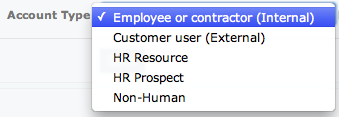Orax SDI Cloud Reference
- Introduction
- Self-Management tools
- Communication and Content management
- Sales and Customer Engagement
- Service Desk
- Project Management
- Automation & Wide-Area-Monitoring
- Job Cards
- Education & B-2-B online training
- Billing and customer statements
- Inventory & Asset management
- Production management
- Human Resources and Payroll
- Procurement and Supply chain
- Ledgers & Accounting
- Reporting and Analytics
- Administration & configuration
User Account Maintenance
SDI User accounts include important data such as Account Status, Account Type (Internal/External/Non-human) and Contact Detail.
An account with an INACTIVE status will prevent the user from logging into the system. To suspend an account, make the status INACTIVE.
A Cellphone number is used for system notifications via SMS as well as for the Contact database. Use the Work extension/telephone field to complete the Contacts database.
The difference between an Employee or Internal Contractor and a Customer/Client is configured in the Employee field upon creation of a User Account (see below).

Always link an account to a properly setup Team. Employee teams are used to link a user to a manager with configured escalations. Customer teams are used to link customer users to their sites. Linking a customer to the wrong team will mean that he/she will have access to sites and work belonging to another company.
Create and link Skills to internal accounts (employees, consultants and contractors) so help desk personnel and project managers will be able to lookup/match Skills for certain tasks and projects.
Privilege linking is very important. All accounts should have the Portal Access privilege.
Customers should have either the Client Users or Client Users - limited access roles. The former is for managers and power users who may access site records. The latter will allow a client user to only see their own calls.
Internal users will almost always have the Work Access role as it gives them access to the Work Space.
Remember that your company may have a unique security privilege setup, so make sure you understand it.
The default roles for internal users are:
1. Sales and Customer Accounts for Sales Executives and Account Managers.
2. Monitor Access for Technicians who configure Monitoring Metrics.
3. Project Access for Project and Account Managers.
4. Suppliers for Procurement.
5. Financial Access for Users who may view financial documents like Quotations and Invoices.
6. Financial Admin for Accountants or users who need to configure financial Parameters and do accounting.
7. Dashboards & Management Reports for Managers.
8. Data, Record and Education admin for Users who manage data records or learning.
9. User Accounts for System Administrators.
10. Settings for Users who setup Work Parameters.
11. Development and Orax Support for Orax Administrators.
If you maintain different languages for your portal, use the Language field to configure a User's account language.



